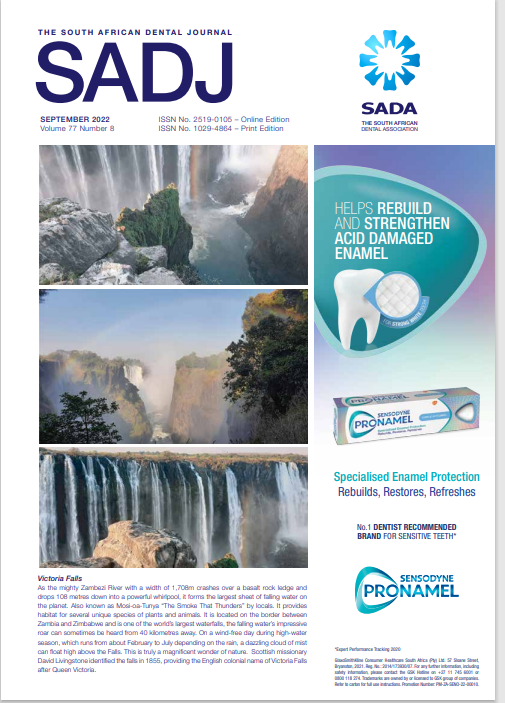The search for a healthy sugar substitute in aid to lower the incidence of Early Childhood Caries: a comparison of sucrose, xylitol, erythritol and stevia
DOI:
https://doi.org/10.17159/2519-0105/2022/v77no8a2Keywords:
Cariogenic potential, erythritol, stevia, Streptococcus mutans, xylitol, CFU, pHAbstract
A pursuit to find a healthy alternative to sucrose with less cariogenic potential, which can potentially lower the incidence of Early Childhood Caries (ECC), by means of comparison. Primary tooth enamel blocks (n=32) were randomly divided into four groups and exposed to 5% concentrations of the respective test groups (sucrose, xylitol, erythritol and stevia). All samples were inoculated
with S. mutans standard strain (ATCC 25175) at room temperature. Analysis of Colony Forming Units (CFUs), acidity measurements (pH) and Scanning Electron Microscopy (SEM) observations were done after 6, 12, 18 and 24 h and compared. After 6 h, the marginal mean CFU count indicated equal S. mutans growth in all groups. Stevia showed lower CFU counts compared to other groups at 12,
18 and 24 h. The pH levels for all non-fermentable sugar substitutes (NSS) initially decreased but never below the critical pH=5.5 and stabilized from 12 to 18 h. The pH levels of sucrose dropped and remained below pH=5.5 at all time intervals. The SEM analysis of
S. mutans supported the CFU results indicating growth in the presence of sucrose and reduction in the presence of the NSS.
Compared to sucrose, xylitol, erythritol and stevia have less cariogenic potential with reduced growth of S. mutans and subsequent acidity levels. Stevia had the least cariogenic potential of all the NSS tested, followed by erythritol and then xylitol.
Downloads
References
Pitts NB, Baez RJ, Diaz-Guillory C, Donly KJ, Alberto Feldens C, McGrath C, Phantumvanit C, Seow P, Kim W, Nikolai S, Yupin S, Norman T, Svante T. Early childhood caries: IAPD bangkok declaration. Journal of Dentistry for Children. 2019; 86(2):72-86.
Patel M. Dental caries vaccine: Are we there yet? Lett Appl microbiol. 2020; 70(1):2-12.
Mäkinen KK, Isotupa KP, Mäkinen P-L, Söderling E, Song KB, Nam SH, Jeong SH. Six-month polyol chewing-gum programme in kindergarten-age children: A feasibility study focusing on mutans streptococci and dental plaque. International dental journal. 2005; 55(2):81-8.
Baer A. Significance and promotion of sugar substitution for the prevention of dental-caries. Lebenson Wiss Technol. 1989; 22(2):46-53.
Imfeld T. Efficacy of sweeteners and sugar substitutes in caries prevention. Caries Res 1993; 27(Suppl. 1):50-5.
O'Donnell K, Kearsley M. Sweeteners and sugar alternatives in food technology: John Wiley & Sons; 2012.
Giacaman RA, Campos P, Munoz-Sandoval C, Castro RJ. Cariogenic potential of commercial sweeteners in an experimental biofilm caries model on enamel. Arch Oral Biol. 2013; 58(9):1116-22.
Pfaffmann C, Young P, Dethier V, Richter C, Stellar E. The preparation of solutions for research in chemoreception and food acceptance. J. Comp. Physiol Psychol. 1954; 47(1):93.
Bauman RW, Machunis-Masuoka E, Cosby CD. Microbiology: With diseases by body system. 3rd ed: Benjamin Cummings San Francisco; 2012.
Glauert AM. Fixation, dehydration and embedding of biological specimens. Volume 3, North- Holland; 1975.
Marshall TA. Low intake of sugars may reduce risk of dental caries. J Evid Based Dent Prac. 2014; 14(2):56-8.
Chan A, Ellepola K, Truong T, Balan P, Koo H, Seneviratne CJ. Inhibitory effects of xylitol and sorbitol on streptococcus mutans and candida
albicans biofilms are repressed by the presence of sucrose. Arch Oral Biol. 2020; 119:104886.
Stephan R. Intra-oral hydrogen-ion concentrations associated with dental caries activity. J Dent Res. 1944; 23(4):257-66.
Ghezelbash GR, Nahvi I, Rabbani M. Comparative inhibitory effect of xylitol and erythritol on the growth and biofilm formation of oral streptococci. Afr J Microbiol Res. 2012; 6(20):4404-8.
15. Takahashi N. Oral microbiome metabolism: From “who are they?” to “what are they doing?”. J Dent Res. 2015; 94(12):1628-37.
Miyasawa-Hori H, Aizawa S, Takahashi N. Difference in the xylitol sensitivity of acid production among streptococcus mutans strains and the biochemical mechanism. Mol Oral Microbiol 2006; 21(4):201-5.
Badet C, Furiga A, Thébaud N. Effect of xylitol on an in vitro model of oral biofilm. Oral health & preventive dentistry. 2008; 6(4)
Jacques N, Hardy L, Campbell L, Knox K, Evans J, Wicken A. Effect of carbohydrate source and growth conditions on the production of lipoteichoic acid by streptococcus mutans ingbritt. Infection and Immunity. 1979; 26(3):1079-87.
de Cock P, Mäkinen K, Honkala E, Saag M, Kennepohl E, Eapen A. Erythritol is more effective than xylitol and sorbitol in managing oral health endpoints. Int J Dent. 2016; 6:1-15.
Downloads
Published
Issue
Section
License

This work is licensed under a Creative Commons Attribution-NonCommercial 4.0 International License.






.png)